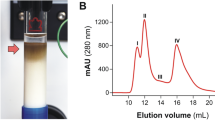Abstract
The ether antigen ofFrancisella tularensis was submitted to fractionation using ammonium sulphate, ethanol and trichloracetic acid (TCA). A simple antigenic mixture was obtained by this fractionation from the original complex ether antigen. However, no separation of antigenically and chemically homogenous substances was achieved, by this procedure. The precipitation with TCA permitted the separation of an antigenic component that was found to be identical with the phenol antigen or its component migrating faster towards cathode in electrophoresis. The sediment obtained possessed common properties with the precipitate obtained by ethanol precipitation. The fraction having the highest anodic mobility could be obtained by salting out the original antigen with ammonium sulphate to 50% saturation. By increasing the concentration of ammonium sulphate to 60% saturation, all components of the ether antigen could be precipitated. The number of precipitation lines in the original antigen and its fractions depends both on the concentration of antigen and the quality of antisera.
Similar content being viewed by others
References
Aleshina E. N., Puchkova T. I.: The fibrinolytic properties of tularemy microbe. (In Russian)Trudy Rostovskogo na Donu Ghos. Nauchno-Issled. Protivochumn. Inst. 6, 96 (1947).
Berenblum I., Chain E.: An improved method for the colorimetric determination of phosphate.Biochem. J. 32, 295 (1938).
Boivin A., Mesrobeanu L.: Contribution á l'étude de la composition chimique de bactéries. Substances azotées et phosphorées “acido-solubles”.Compt. Rend. Soc. Biol. 112, 76 (1933).
Dische Z. Über Mikrobestimmung der Kohlenhydrate in tierischen Organen und im Blute mit Hilfe charakteristischer Farbreaktionen.Mikrochemie 7, 33 (1929).
Francis E., Evans A. Agglutination, cross-agglutination and agglutination absorption in tularemis.Publ. Health Rep. 41, 1273 (1926).
Galperin M. E.: The striction method for detection of toxins in infectious diseases.Autoref., Diss. Thesis, Moscow 1955.
Grabar, P., Burtin P.: Immunoelectrophoretic Analysis. p. 39 Elsevier Publ. Co., Amsterdam 1964.
Kalacheva A. G., Kleush-Ivanova Z. P., Kratinova P. N.: The effect of tularemia toxin on the striction reaction of tissues. (In Russian)Zh. Microbiol Epidemiol. Immunol. 1; 77 (1948).
Kalacheva N. F.: Serological affinity of strains of tularemia and the differencies of tularemy and brucella microbes. (In Russian)Tr. Inst. “Microbiol”, Sarator1, 115 (1951).
Lowry O. H., Roseborough N. J., Farr A. L., Randall R. J.: Protein measurement with the Folin phenol reagent.J. Biol. Chem. 193, 265 (1951).
Ormsbee R. A., Bell J. F., Larson C. L.: Studies ofBacterium tularense antigens. I. The isolation, purification and biologic activity of antigen preparations fromBacterium tularense.J. Immunol. 74, 351 (1955).
Ormsbee R. A., Larson C. L.: Studies onBacterium tularense antigens. II. Chemical and physical characteristics of protective antigen preparations.J. Immunol. 74, 359 (1955).
Owen C. R., Bell J. F., Larson C. L., Ormsbee R. A.: Virulence ofBacterium tularense. II. Evolution of criteria of virulence ofBacterium tularense.J. Inf. Diseases,97, 167 (1955).
Óz T. V.: Endotoxin ofPasteurella tularensis.Türk. Ztschrf. Hyg. Exp. Biol. II, 187 (1940).
Shipitsina C. K. Chemical composition of antigenic material of tularemia.Proc. Acad. Sci USSR 105, 315 (1955).
Shipitsina C. K.: The correlation of chemical structure of specific material of tularemy, microbe and its virulence. Thesis Conf.: Variability of microorganisms and bacteriophagy. p. 63 (1958).
Skrodzki E.: Characteristic ofB. tularense strains cultivated in Poland in the years 1952–53.Med. Doświad. Mikrobiol. 1, 65 (1956).
Škvařil F.: The micromodification of immunoelectrophoresis. (In Czech)Chem. listy 55, 1069 (1961).
Tinker I. S., Drozhevkina M. S., Konnova A. M., Grzhebina N. K. The whole antigen of tularemy microbe.Sborn. Tr. Astrakhan. Protivochumn. Stantsii 1, 135 (1955).
Vereninova N. K. The diffusion factor of tularemy microbe. (In Russian)Tr. Inst. “Mikrob”, Saratov1, 39 (1951).
Vereninova N. K., Kontorina, A. A., Bakhrakh Ye. E.: The characteristic of polysaccharide-containing fractions of tularemy microbe. (In Russian)Zh. Mikrobiol. Epidemiol. Immunol. 2, 8 (1956).
Yemelyanova O. S.: Some problems of microbiology of tularemia. (In Russian)Zh. Mikrobiol. Epidemiol. Immunol. 11, 10 (1946).
Author information
Authors and Affiliations
Rights and permissions
About this article
Cite this article
Procházka, O., Dubanská, H. The antigenic structure ofFrancisella tularensis . Folia Microbiol 17, 232–238 (1972). https://doi.org/10.1007/BF02875819
Received:
Revised:
Issue Date:
DOI: https://doi.org/10.1007/BF02875819




